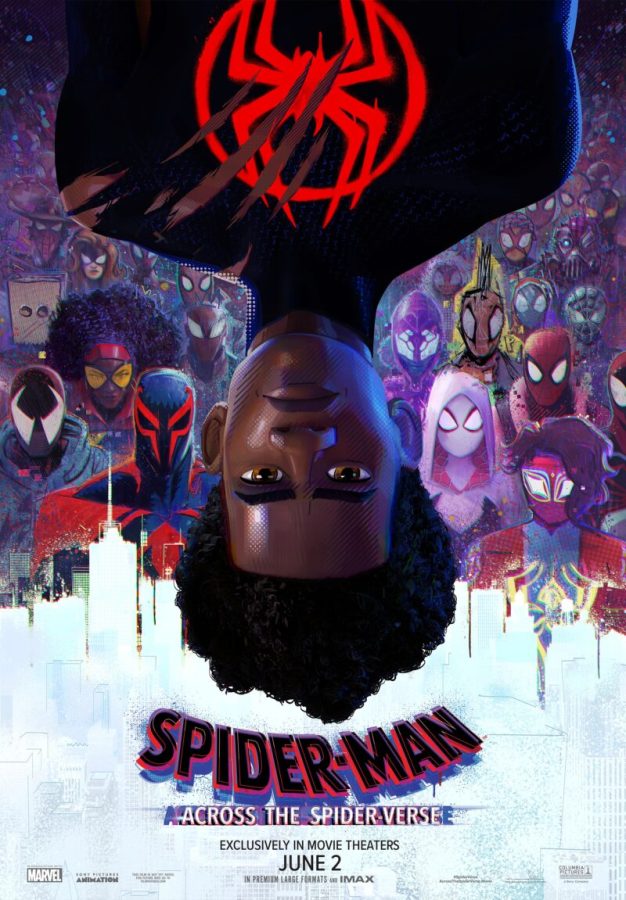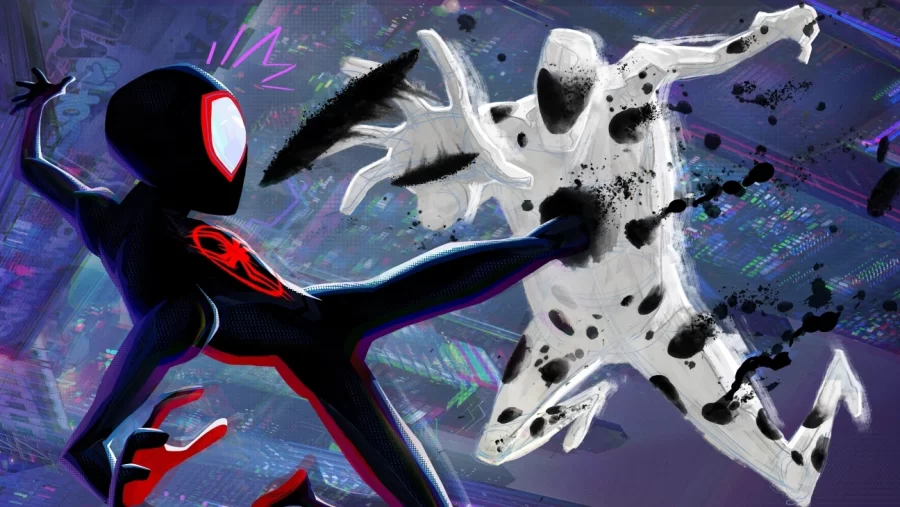‘Spider-Man: Across the Spider-Verse’: The Best a Comic Book Movie Can Be

(Image courtesy of Sony Pictures)
June 10, 2023
“Spider-Man: Into the Spider-Verse” is my favorite Spider-Man movie. This was a fact I had a hard time swallowing when the film was initially released in the winter of 2018. I have been a massive fan of the web-slinging superhero all my life. Growing up, I read the comics, traversed my neighborhood streets on a Spider-Man Big Wheel and watched Sam Raimi’s Spider-Man films on repeat. My personal favorite was the second movie.
Spider-Man defined my personal moral code and taught me how to be my best self in this chaotic world. “Spider-Man: Into the Spider-Verse” caught me off guard at first, with the film focusing on the “multiverse” and a new character: Miles Morales. It wasn’t until a few rewatches that I realized that the film was not only a technological masterpiece in the animation landscape, but also a perfect celebration of the Spider-Man character. With all this in mind, you can imagine my expectations for the sequel, “Spider-Man: Across the Spider-Verse,” were pretty high.
In “Spider-Man: Across the Spider-Verse,” an older and more experienced Miles Morales has fully embodied his role as Spider-Man. After a reunion with his fellow Spider-hero Gwen Stacy, Miles is introduced to a society of Spider-people from across the multiverse. Tensions run high when a new threat pits Miles against the Spider-society, forcing him to redefine what it means to be a hero.
Another Milestone in Animation
There is simply too much to discuss about “Across the Spider-Verse” to fit it all here, so let’s begin with the obvious. Many feel “Into the Spider-Verse” was a milestone in the history of animation, showing how moving drawings on the big screen could be pushed to their full potential. The sequel takes this idea even further, using its multiverse subject matter to explore the diverse world of animation.
Each universe Miles visits has its own distinct art style that matches its characters and the themes it represents. The film embraces its comic origins, filling every corner of the screen with detail and references for fans. Nearly every frame in the film is worthy of its own individual praise and study. While I absolutely adored how energized the animation was, I could see some being overwhelmed by the scope and non-stop creative explosion on screen. I have no doubt this movie will steal the Oscar for Best Animated Feature next March.

A More Mature Sequel
When it comes to the narrative of “Across the Spider-Verse,” I was completely taken by how hard it swings for the fences. I rarely use the word “epic” to describe films, but here it feels wrong not to. “Across the Spider-Verse” is an epic story that makes “Into the Spider-Verse” feel like a quaint side adventure. The first half of the film moves at a slower pace: most scenes are dedicated to allowing characters to sit and speak to each other, establishing an emotional core that will later tug at the audience’s heartstrings. This half also features the majority of the humor in the film, which is just as consistently laugh-out-loud funny as the first. Once Miles enters the “Spider-Verse,” though, things begin to get fast, intense and surprisingly dark.
The second half of the film moves at a breakneck pace, throwing enough information at the audience that, at times, it feels hard to carry. If you aren’t keeping speed with the film, you’re going to be left behind. If you are fast enough to keep up, you’re rewarded with a mature story that comments on the decades-long history of comic-book storytelling. It also brings up moral issues that will leave even the most decisive viewers feeling conflicted. “Across the Spider-Verse” put me in an uncomfortable position, reframing my perspective on the legacy of Spider-Man and what heroism is. While “Into the Spider-Verse” was a celebration of the character and what he stands for, “Across the Spider-Verse” is an examination of his stories and the tragedy that is imbued at the center of the character.
The Characters of the Spider-Verse
Shameik Moore as Miles Morales is as charming as ever, but is asked to inject a lot more sadness and struggle into his voice work when compared to the original. Like every Spider-hero variation, Miles is forced to balance being a hero with his ordinary life. We get to see Miles have to defend his title as Spider-Man, making him an underdog that is easy to root for. Hailee Steinfeld as Gwen Stacy is given more screen time to fully flesh out her character and make her more than just a romantic lead for Miles. Like Moore, Steinfeld evolves her voice work to really hit those emotional beats and add complexity to her role. A ton of new Spider-people are introduced in “Across the Spider-Verse,” but my favorite new character is Jason Schwartzman as the inter-dimensional villain, Spot. Somehow equal parts goofy and menacing, the Spot serves as a fantastic antagonist for Miles and the “Spider-Verse” franchise. Not only do his powers perfectly complement the animation medium, but his smooth transition from silly dork to a threatening, god-like entity is deeply unsettling.

“Spider-Man: Across the Spider-Verse” is only half of a story, as the finale to this trilogy, “Spider-Man: Beyond the Spider-Verse” is set to release early next year. Because of this, the film ends with its conflict unresolved in a very “Back to the Future Part II” type of way. I could see this making many feel unsatisfied as they leave the theater, but for me it just makes me want to rewatch “Across the Spider-Verse.” This is the height of what comic book films, animated films, and films can be as a whole. I cannot wait to swing back into theaters to see this again, and I think you’ll feel the same way after this truly spectacular experience.







